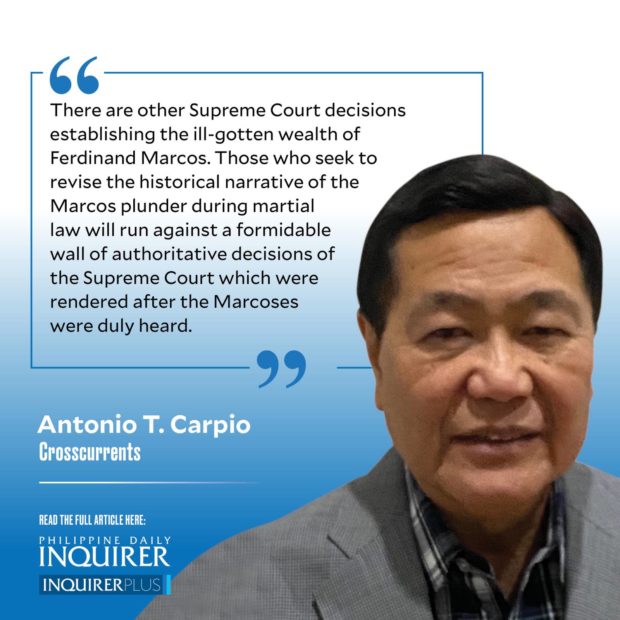The Supreme Court as historian

The Constitution mandates that every decision on the merits of the Supreme Court must “state clearly and distinctly the facts and the law on which it is based.” The most important issues facing the nation often involve legal issues, eventually ending up for decision by the Supreme Court. Since these decisions state “the facts and the law,” these decisions record for posterity the history of the nation. These decisions are final and binding on the parties and on the nation. No historical revisionism of any kind can alter or erase these final and binding decisions.
Last Sept. 21, 2021, the nation marked the 49th anniversary of the declaration of martial law by then President Ferdinand Marcos who abolished Congress and made himself the dictator of the Philippines, ruling the country by decree. The martial law period also saw the plunder of the nation by President Marcos and his cronies. This plunder is established and recorded for posterity in several decisions of the Supreme Court, two of which involve the secret Marcos foreign bank accounts.
First is the landmark 2003 case of Republic v. Sandiganbayan, a unanimous en banc decision of the Supreme Court which forfeited in favor of the Philippine government $658 million in Swiss bank accounts of Ferdinand and Imelda Marcos as ill-gotten wealth. The respondents in this case are the entire Marcos family, composed of Imelda Marcos, Bongbong Marcos, Imee Marcos, and Irene Marcos, who in their pleadings claimed ownership of the $658 million Swiss accounts. The Supreme Court found that “respondents judicially admitted that the money deposited with the Swiss banks belonged to them,” even as the Swiss accounts were in the names of five foreign foundations.
The Court used as legal basis for the forfeiture Section 2 of Republic Act No. 1379, a 1955 law which expressly states: “Whenever any public officer or employee has acquired during his incumbency an amount of property which is manifestly out of proportion to his salary as such public officer or employee and to his other lawful income and the income from legitimately acquired property, said property shall be presumed prima facie to have been unlawfully acquired.”
The Court found that the “spouses Ferdinand and Imelda Marcos were public officials during the time material to the instant case” and their only lawful source of income were their government salaries. The Court approved the computation by the Solicitor General of all the possible legal income of Ferdinand and Imelda Marcos, and this amounted to only $304,372.43. The Court ruled: “The sum of $304,372.43 should be held as the only known lawful income of respondents since they did not file any Statement of Assets and Liabilities (SAL), as required by law, from which their net worth could be determined.”
The Court thus forfeited as unlawfully acquired wealth the Swiss accounts, disposing the case as follows: “The Swiss deposits which were transferred to and are now deposited in escrow at the Philippine National Bank in the estimated aggregate amount of US$658,175,373.60 as of January 31, 2002, plus interest, are hereby forfeited in favor of petitioner Republic of the Philippines.”
Second are the 2012 consolidated cases of Marcos Jr. v. Republic and Imelda Marcos v. Republic, which involved the $3,369,975 account of Arelma, Inc., with Merrill Lynch of New York, USA. The Court’s Second Division quoted with approval the Petition for Forfeiture which narrated: “When the Marcos family fled Manila in 1986, they left behind several documents that revealed the existence of secret bank deposits in Switzerland and other financial centers. These papers xxx detailed how ‘Arelma, Inc.’ was established. xxx The latter (Arelma) was to have the same set-up as Maler, one of the five Swiss foundations xxx.” In Marcos Jr. v. Republic, Bongbong Marcos claimed, as one of the heirs of Ferdinand Marcos, ownership of the Arelma deposit. The Court, however, citing the earlier 2003 case of Republic v. Sandiganbayan, ruled that the Arelma deposit was part of the unlawfully acquired wealth of Ferdinand Marcos.
There are other Supreme Court decisions establishing the ill-gotten wealth of Ferdinand Marcos. Those who seek to revise the historical narrative of the Marcos plunder during martial law will run against a formidable wall of authoritative decisions of the Supreme Court which were rendered after the Marcoses were duly heard.




















